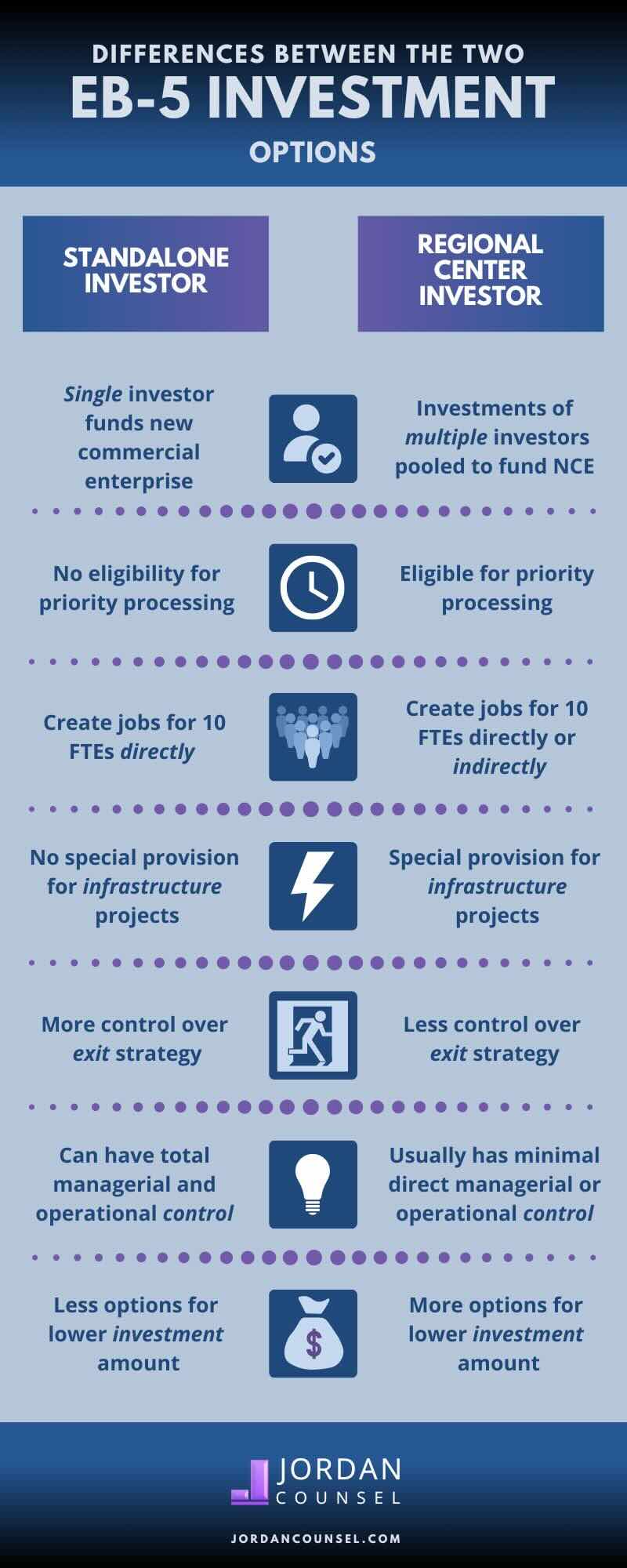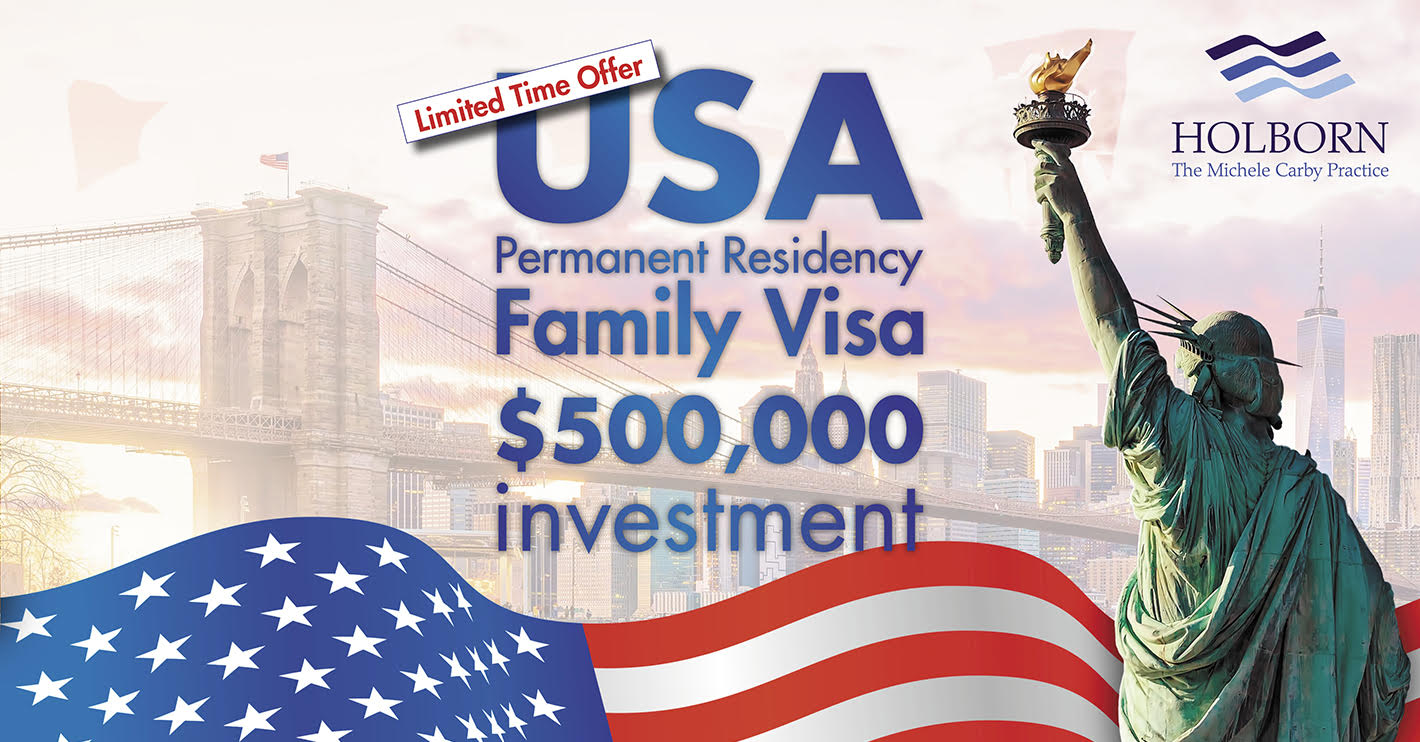EB-5 Visa Explained: Exactly How to Obtain a Visa Through Financial Investment
The EB-5 Visa program provides a special opportunity for foreign investors seeking united state irreversible residency with an organized financial investment strategy. With details qualification criteria and financial investment thresholds, the procedure calls for careful consideration and calculated preparation. Understanding the subtleties of the application procedure, consisting of the differences in between regional centers and straight investments, is crucial for prospective candidates. As this pathway unravels, prospective financiers must navigate different advantages and challenges that accompany it. What are the vital aspects that can affect the success of an EB-5 application?
Overview of EB-5 Visa
The EB-5 Visa program, designed to boost the united state economy with international investment, provides a pathway to permanent residency for qualified investors and their households. Developed by the Immigration Act of 1990, the program aims to attract international funding to produce tasks and enhance economic development in the United States. Investors that add a minimum quantity to an approved project can obtain this visa, thereby allowing them to purchase various fields, including genuine estate, facilities, and various other companies.
The EB-5 program is specifically appealing due to its double advantages: a chance for financial returns on financial investments and the possibility for united state citizenship. By buying targeted work areas (TEAs), which are specified as rural areas or areas with high joblessness, financiers may get approved for a minimized investment threshold. The program requires the development of at the very least ten full time work for U.S. workers as a straight outcome of the financial investment. Effective applicants obtain a conditional visa for two years, after which they can get long-term residency, offered they satisfy all program requirements. This pathway has gathered attention from financiers internationally, making it a crucial component of U.S. immigration plan.
Qualification Standards
To get approved for the EB-5 Visa, capitalists have to meet specific eligibility requirements that assure their financial investment adds to work creation and economic development in the USA - EB-5 Investment Amount. Firstly, applicants must spend a minimum of $1 million in a brand-new business, or $500,000 if the investment is made in a targeted employment location (TEA), which is usually characterized by high unemployment or country places
Additionally, the enterprise has to create or protect at the very least 10 permanent tasks for certifying U.S. employees within two years of the financier's admission to the USA. Capitalists are additionally needed to demonstrate that their investment funds were obtained via lawful ways, giving evidence such as income tax return and bank statements.
One more essential standard is that the financial investment must remain in a for-profit company entity that was developed after November 29, 1990, or one that has actually been restructured or expanded to meet the EB-5 needs. Lastly, applicants need to demonstrate their intent to proactively take part in business, guaranteeing that their participation adds to its success. Satisfying these qualification requirements is necessary for financiers looking for to get irreversible residency with the EB-5 program.
Financial investment Options
When taking into consideration the EB-5 visa, investors should assess their alternatives in between straight financial investment possibilities and regional facility programs. Each option brings certain work production demands that are vital for satisfying the visa requirements. Comprehending these financial investment opportunities is vital for making an educated choice that straightens with both financial goals and immigration objectives.
Direct Investment Opportunities
Direct investment possibilities under the EB-5 Visa program provide foreign capitalists with a path to acquire U.S. permanent residency while adding to the American economic situation. Unlike regional facility investments, direct investments call for capitalists to proactively manage their business ventures within the U.S., enabling for potential better control and impact over their financial investment outcomes.
To receive the EB-5 Visa through direct financial investment, foreign nationals should spend a minimum of $1 million in a new commercial enterprise or $500,000 in a targeted work location, which is defined as a rural area or a region with high unemployment. The financial investment needs to lead to the production of a minimum of ten permanent jobs for qualifying united state workers within two years.
Straight investment alternatives can differ extensively, including fields such as property growth, innovation, hospitality, and manufacturing startups. Investors need to conduct detailed due diligence to assess the viability of their chosen organization design and assurance conformity with EB-5 policies. Involving with legal and monetary experts experienced in EB-5 matters is recommended to navigate the complexities of straight investment chances and optimize the possibility for a successful application.
Regional Facility Programs
Leveraging the EB-5 Visa program, regional facility programs supply a structured financial investment method for foreign nationals looking for U.S. irreversible residency. These programs are designated by the U.S. Citizenship and Migration Services (USCIS) and focus on merging financial investments to money various economic growth jobs, which might consist of genuine estate, facilities, and organization ventures.
Capitalists typically add a minimum of $900,000 in targeted work locations or $1.8 million in various other regions. EB-5. Among the primary benefits of regional facility programs is that they enable capitalists to fulfill the EB-5 investment demands through indirect work creation, as opposed to route task development needed in straight investment opportunities
Regional centers take care of the financial investment in support of the investors, supplying a more passive strategy than straight financial investment. This monitoring includes managing project advancement, monetary coverage, and compliance with USCIS regulations. Additionally, local centers usually have developed track records, improving the self-confidence of potential financiers.
Inevitably, regional center programs present an engaging choice for those seeking to browse the complexities of the EB-5 Visa procedure while contributing to united state financial growth and work creation.
Job Creation Needs
To qualify for an EB-5 Visa, financiers must validate that their capital financial investment leads to the production of at least 10 full-time jobs for U.S. workers within 2 years. This job production demand is a vital part of the EB-5 program, designed to boost the U.S. economic climate and promote try this website economic growth.
Capitalists can choose between two primary investment alternatives: straight financial investments and financial investments via Regional Centers. With straight investments, the financier should actively take care of the organization and guarantee work production, while additionally demonstrating that the jobs developed are for U.S. people or lawful irreversible homeowners. Alternatively, Regional Facility financial investments permit investors to pool their resources into a designated project, commonly leading to indirect job development, which can be counted towards meeting the task demand.
To effectively meet the work creation criteria, it is essential for capitalists to work closely with experienced experts who can guide them via the complexities of the EB-5 program. Correct preparation and adherence to policies are essential to confirm compliance and safeguard a course to irreversible residency. Failure to satisfy these task creation needs can endanger the investor's EB-5 application and their migration condition.
The Application Process
The application procedure for the EB-5 visa entails a series of essential steps and details eligibility demands that candidates must fulfill. Understanding these standards is important for an effective application. This section will certainly lay out the essential credentials and provide a step-by-step guide to guiding via the procedure.

Qualification Needs Introduction
Comprehending the qualification needs for the EB-5 visa is important for potential investors wanting to obtain long-term residency in the United States. To certify, a private have to show a minimum financial investment of $1 million in a brand-new company, or $500,000 if the investment is made in a Targeted Work Area (TEA), which is specified as a rural area or one with high joblessness.
The capitalist has to show that the financial investment will certainly maintain or produce at least 10 full time jobs for U.S. workers within two years of the financial investment. The venture must also be a for-profit entity and has to be freshly developed or considerably redesigned if it is an existing company.
The candidate should show that the mutual fund are gotten through lawful methods, including personal cost savings, gifts, or finances sustained by proper documentation. Additionally, the investor has to proactively take part in business, guaranteeing their engagement in the monitoring of the enterprise. Satisfying these qualification requirements is essential for an effective EB-5 application and ultimately securing a copyright with this investment avenue.
Step-by-Step Procedure
Once eligibility requirements are met, prospective investors can begin the application procedure for the EB-5 visa. The initial step entails finishing Kind I-526, the Immigrant Petition by Alien Financier. This form has to be gone along with by supporting documentation that demonstrates the investor's certifying financial investment and the production of at the very least ten permanent tasks for united state employees.
Upon approval of Kind I-526 by the USA Citizenship and Migration Services (USCIS), capitalists can apply for the EB-5 visa with either consular handling or modification of condition, relying on their present residency. For those outside the U.S., this suggests sending a visa at an U.S. consulate. Alternatively, if currently in the U.S., applicants need to file Form I-485, Application to Register copyright or Change Status.
After authorization, capitalists and their qualified member of the family obtain conditional long-term residency for 2 years. Within 90 days prior to the expiry of this conditional condition, financiers should file Type I-829, Petition by Business Owner to Get Rid Of Problems, to obtain irreversible residency. Successful completion of this step finalizes the EB-5 investment process, providing the capitalist a Visa.
Regional Centers vs. Direct Investments
Navigating the EB-5 visa program entails a vital decision in between local centers and direct financial investments, each offering distinctive pathways to getting long-term residency in the USA - EB-5 Visa by Investment. Regional facilities are designated by the United States Citizenship and Immigration Provider (USCIS) to promote economic development via work development. When spending via a regional center, capitalists commonly contribute to a pooled fund, which is handled by the center. This choice often allows for a more passive investment technique, as the facility looks after the job and job creation demands
On the other hand, straight financial investments call for investors to proactively handle their very own service ventures in the United States. This strategy demands a much more hands-on participation, as the capitalist should maintain and develop a minimum of 10 full time jobs directly associated to their company. While straight financial investments might supply higher control over the investment result, they additionally entail greater obligations and dangers.
Ultimately, the option between straight financial investments and regional centers depends upon individual danger resistance, wanted involvement level, and investment goals. Comprehending these distinctions is essential for investors looking for to navigate the intricacies of the EB-5 visa program successfully.
Benefits of the EB-5 Visa
The EB-5 visa program supplies many benefits for international financiers seeking irreversible residency in the USA. Among the most significant benefits is the chance for financiers and their instant relative, including partners and children under 21, to obtain an eco-friendly card, approving them the right to function and live in the U.S. forever.
The EB-5 program does not call for a sponsor, allowing capitalists higher autonomy in their immigration journey. This program additionally offers a pathway to citizenship after 5 years of long-term residency, assisting in long-term stability for families. Additionally, investing through designated Regional Centers can be much less difficult, as these entities frequently handle the project and work production needs on part of the capitalist.
The EB-5 visa can lead to considerable economic returns, as investments are usually routed towards commercial business that can produce profits. By contributing to financial development and work development in the U.S., EB-5 financiers play an essential duty in improving neighborhood communities. Overall, the EB-5 visa works as a compelling alternative for those seeking to safeguard a future in the USA while making a favorable effect.
Common Difficulties and Considerations
While the EB-5 visa program offers appealing benefits for foreign capitalists, it also includes its share of obstacles and considerations that possible applicants should very carefully examine. One considerable difficulty is the monetary dedication involved, as the minimum investment amount is substantial, usually evaluated $1 million or $500,000 in targeted work locations. Capitalists need to ensure that they have adequate resources and a clear understanding of the connected threats.

Furthermore, prospective financiers need to conduct detailed due persistance on the investment jobs to prevent illegal systems. The success of an EB-5 application depends upon the production of a minimum of 10 full time tasks for U.S. employees, necessitating careful preparation and monitoring of business's performance (EB-5 Investment Amount). Inevitably, navigating these challenges needs a tactical approach and frequently the assistance of seasoned experts in migration and financial investment law
Regularly Asked Inquiries
For how long Does the EB-5 Visa Process Generally Take?

Can Household Members Apply With the Key EB-5 Candidate?
Yes, relative can apply along with the primary applicant. EB-5 Visa by Investment. Qualified dependents typically consist of partners and unmarried children under 21, permitting them to obtain copyright contingent upon the key applicant's successful visa authorization
What Takes place if My Investment Falls short?
It may endanger your immigration standing and the capacity for obtaining a copyright if your investment fails. It's essential to carry out complete due diligence and consider risk mitigation approaches before waging any financial investment.
Exist Age Restrictions for EB-5 Investors?
There are no specific age constraints for EB-5 investors; however, the private have to go to least 18 years of ages to legitimately become part of investment agreements. Minors may qualify with adult investment and sponsorship.
Can I Traveling Outside the United State During the Application Process?
Taking a trip outside the U.S. throughout the application process may impact your standing. It is recommended to consult with a migration attorney to comprehend potential threats and assurance compliance with all demands while your application is pending.
Regional centers take care of the investment on part of the investors, providing a more passive strategy than straight investment. To qualify for an EB-5 Visa, capitalists need to confirm that their funding financial investment results in the creation of at the very least ten permanent work for U.S. employees within two years. Investors can choose between two main investment options: direct investments and financial investments via Regional Centers. The financier has to reveal that the investment will protect or create at least 10 permanent tasks for United state workers within two years of the investment. Inevitably, the selection in between local centers and straight investments pivots on private threat resistance, preferred participation level, and financial investment objectives.